- Boshart Knowledge Base
- Hose Fittings
-
Air Volume Controls
-
American Iron and Steel
-
Back Flow Prevention
-
Ball Valves
-
Bleeder Orfice
-
Brass Fittings
-
Bronze Threaded Pipe Fittings
-
Certifications
-
Check Valves
-
Chemical Compatibility
-
Chemical Composition
-
Clamps
-
Compression Coupling
-
Compression Fittings
-
Conflict Minerals
-
Constant Pressure Manifold
-
Control Box
-
CRN
-
Dielectric
-
Drain Back Valve
-
Drain Valves
-
Electrodes
-
Feet of Head
-
Filter Cartridge
-
Filter Housing
-
Filter Housings
-
Filtration
-
Flanges
-
Flare Fittings
-
Float Switch
-
Float Valve
-
Float Valves
-
Flow Controls
-
Foot Valves
-
Gallons
-
Galvanized
-
Gas
-
Gas Connector
-
Gate Valves
-
Gauges
-
Hand Pump
-
Heat Shrink
-
Hose
-
Hose Bibb
-
Hose Fittings
-
Insert Fittings
-
Iron Out
-
Jet Pumps
-
Leathers
-
Level Alarms
-
Literature
-
Malleable Iron Fittings
-
Manifolds
-
Merchant Coupling
-
Merchant Steel
-
Mounting Bracket
-
MTR
-
NPT Threads
-
NSF
-
O-Rings
-
PEX Fittings
-
PEX Valves
-
Pig Tail Syphon
-
Pipe
-
Pipe Column
-
Pipe Fittings
-
Pipe Nipples
-
Pitless
-
Pitless Adapter
-
Pitless Unit
-
Pressure Gauge
-
Pressure Snubber
-
Pressure Switch
-
Pressure Tank
-
PTFE
-
Pump Cable
-
Pump Saver
-
Push-Fit
-
PVC Fittings
-
PVC Pipe
-
Ratings
-
Relay
-
Relief Valves
-
Rope
-
Rope Hanger
-
Safety Data Sheets
-
Sewage Valves
-
Shaft Seals
-
Snifter Valve
-
SPIN-DOWN
-
Stainless Steel
-
Stainless Steel Fittings
-
Steam
-
Stop & Waste Valves
-
Sump Pump
-
Sump Pump Check Valve
-
Sweat
-
Tank Tee
-
Tank Tees
-
Technical Support
-
Thermometer
-
Thread Sealants
-
Torque Arrestor
-
Trouble Shooting
-
Tubing
-
Unit Conversions
-
Vacuum Breaker
-
Wall Hydrant
-
Warranty
-
Water Well Accessories
-
Well Cap
-
Well Caps
-
Well Packers
-
Well Point
-
Well Seal
-
Well Water Systems
-
Wire
-
Wiring
-
WROT
-
Yard Hydrants
-
Electrical Enclosures
-
Transition Couplings
-
Water Box
-
PEX Pipe
-
Combination Valve
-
Well Screen
-
Flowing Well
-
RoHS - Restriction of Hazardous Substances
-
Electrical Tape
What are hose fittings used for?
There are two major types of hose fittings: combination nipples and hose menders.
Combination nipples are made from tubular stock and are used to transition from hose to pipe, adapters, strainers, or valves.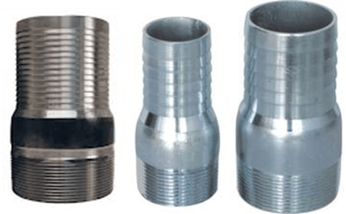
Hose menders are used to connect two lengths of hose together or to repair a section of hose that has been damaged.
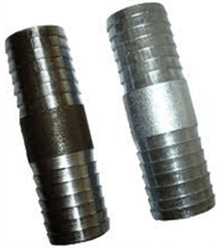
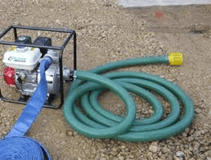 Hose fittings are designed to be used with thermoplastic and natural rubber straight end hoses. These connections should be used for fluid service only. Hose fittings are recommended for low-pressure discharge assemblies and suction service for compatible liquids such as in trash pump and discharge hose applications.
Hose fittings are designed to be used with thermoplastic and natural rubber straight end hoses. These connections should be used for fluid service only. Hose fittings are recommended for low-pressure discharge assemblies and suction service for compatible liquids such as in trash pump and discharge hose applications.

Hose fittings are not to be used with compressible gases, high pressure air, steam or any critical application as they could result in blow off. Hose fittings are not to be used with PE pipe. The smaller OD serrations may result in hose blow off.
To identify hose fittings from polyethylene (PE) pipe fittings, look at the lead barb design. Hose fittings are machined with a special lead barb that makes installation into reinforced hoses easier compared to PE pipe fittings which have a tapered lead barb.
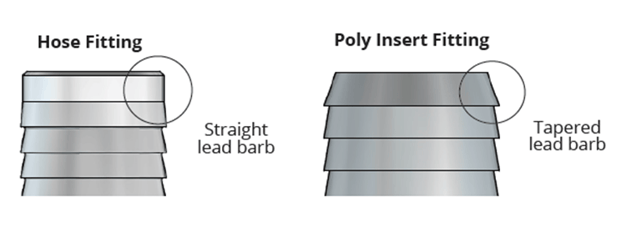
To install a hose fitting,
- Cut the hose cleanly and square to length.
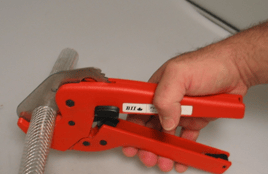
- Slide a hose clamp onto the hose.
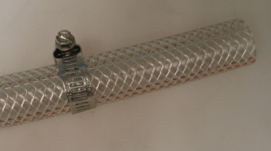
- Lubricate the hose barb and push the hose onto the barb until the hose bottoms out on the hex or shoulder.
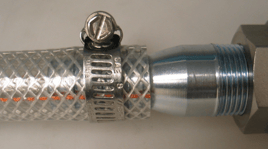
- Position the hose clamp approximately ¼” back from the hex and tighten the clamp.
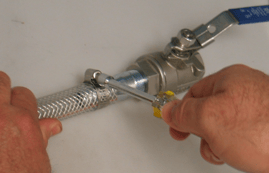
Additional Resources:
https://support.boshart.com/how-to-install-a-worm-gear-hose-clamp
https://support.boshart.com/why-wont-the-hose-fit-onto-the-combination-nipple
